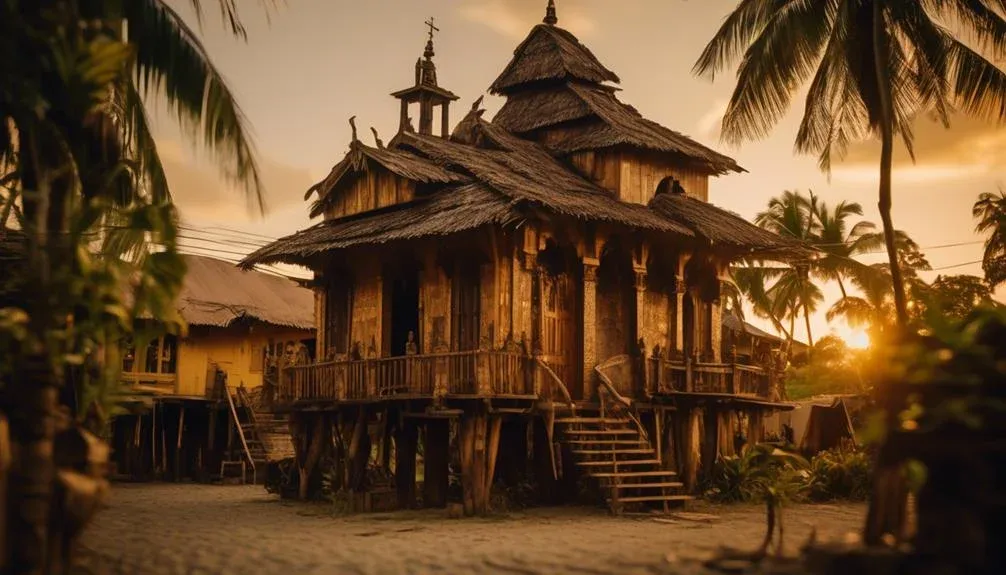How to Explore Historic Filipino Architecture Gems

Are you ready to unlock the secrets of the past and embark on a fascinating journey through time? Join us as we unveil the hidden treasures of Historic Filipino Architecture Gems. These architectural wonders are like time capsules, each one holding stories of resilience, adaptation, and cultural fusion.
In this blog, we’ll take you on a tour of architectural wonders, from the ancient Bahay Kubo on stilts to the Spanish-influenced fortresses. It’s a blend of history where indigenous creativity meets colonial influences, and where sustainability and modern restoration techniques work together to preserve our heritage.
Let’s explore a world where stone and mortar tell the story of a nation’s rich past.
Key Takeaways
- Ancient Filipino architecture reflects a harmonious relationship with nature, community cohesion, and environmental respect.
- Colonial influences introduced new materials such as stone and brick, blending local and foreign architectural styles.
- Indigenous materials like bamboo and nipa palm are versatile and sustainable, while elevated structures on stilts and adaptive layouts promote natural ventilation and light.
- Preserving Filipino architectural heritage requires science, sensitivity, and modern restoration techniques, along with digital archiving initiatives for ongoing research, education, and awareness.
Understanding Ancient Filipino Architecture
Ancient Filipino architecture, particularly the “Bahay Kubo” or ancestral homes, showcases a deep connection to the environment and a sustainable way of living. These homes are elevated on stilts to adapt to flood-prone areas, symbolizing protection and respect for nature.
The steeply pitched roofs made from nipa palm not only shed rain but also symbolize community unity and strength. The materials used, such as bamboo, wood, and thatch, highlight a sustainable relationship with the environment.
Overall, ancient Filipino architecture reflects a society that values harmony with nature, community cohesion, and a profound respect for their environmental context.
Colonial Influences on Filipino Structures
The arrival of Spanish colonizers in the 16th century marked a pivotal shift in Filipino architecture, introducing new materials, techniques, and religious motifs that profoundly shaped the built environment. Spanish fortifications, such as the Intramuros in Manila, exemplify the military engineering and strategic urban planning implemented to protect their newfound territories.
These structures were not merely defensive bastions but also served as administrative and religious centres, incorporating European baroque and Renaissance architectural elements into the local landscape.
As you dig deeper into the colonial era, you’ll notice the introduction of stone and brick, replacing the indigenous bamboo and nipa. This transition not only signified a change in materials but also in the architectural narrative, with churches, government buildings, and houses reflecting a blend of local and foreign influences.
The American period introduced new architectural styles and urban planning concepts, emphasizing sanitation, education, and transportation. The expansion of roads, bridges, and public buildings during this era contributed to the modernization of Filipino architecture, incorporating reinforced concrete and adopting the Art Deco style, which can be seen in many structures from this period.
Indigenous Materials and Construction Techniques
Before the colonial era reshaped its landscape, Filipino architecture was deeply rooted in the use of indigenous materials and construction techniques, reflecting an intimate understanding of the local environment and cultural identity.
This approach not only showcased the ingenuity of pre-colonial Filipino communities but also highlighted the sustainability practices inherent to their architectural endeavours.
Key elements include:
- Bamboo Versatility: Bamboo was central to traditional Filipino architecture, celebrated for its strength, flexibility, and rapid regeneration. Its use ranged from structural elements to decorative features, embodying a balance between durability and aesthetic appeal.
- Nipa Sustainability: The nipa palm provided roofing materials that were both effective in tropical climates and biodegradable. This choice emphasized a harmonious relationship with the natural world, prioritizing materials that could be sustainably harvested and replaced.
- Elevated Structures: To combat flooding and pestilence, many indigenous homes were elevated on stilts, a technique that also optimized airflow, reducing the need for artificial cooling.
- Adaptive Layouts: The spatial organization within these structures was inherently adaptable, allowing for natural ventilation and light, and reducing the reliance on non-renewable energy sources.
These techniques and materials underscore a profound respect for nature, showcasing an architectural philosophy that seamlessly blends functionality, environmental consciousness, and cultural expression.
Preserving Filipino Architectural Heritage
Efforts to preserve Filipino architectural heritage necessitate a nuanced understanding of its historical context and cultural significance, ensuring these structures aren’t just relics but living embodiments of national identity. In this vein, modern restoration techniques and digital archiving initiatives serve as critical tools in safeguarding these cultural treasures.
Modern restoration techniques are grounded in both science and sensitivity to the original aesthetic and structural integrity of historic buildings. Techniques such as structural reinforcement, materials conservation, and adaptive reuse are employed with meticulous attention to detail, ensuring that interventions are reversible and do not compromise the historical value of the architectural work. This approach not only preserves the physical aspects of heritage buildings but also maintains their historical narratives and cultural relevance.
Simultaneously, digital archiving initiatives have emerged as a complementary tool in the preservation toolkit. By documenting and creating digital replicas of architectural landmarks, these initiatives offer an innovative way to study, conserve, and promote Filipino architectural heritage.
Digital archives ensure that detailed information about these structures is accessible to future generations, facilitating ongoing research, education, and awareness.
Moreover, in the face of natural disasters or human-induced threats, digital archives provide a valuable backup, ensuring that the essence and knowledge of these architectural gems are not lost to time.
Visiting Historical Landmarks in the Philippines
Having explored the intricate methods of preserving Filipino architectural heritage, it’s crucial to consider how these endeavours impact your experience when visiting historical landmarks in the Philippines. The preservation efforts not only highlight the architectural magnificence but also enforce guidelines that ensure these monuments endure for future generations.
This brings into focus the importance of adhering to tourist etiquette and understanding photography restrictions, which play pivotal roles in the conservation process.
Here are four essential aspects to consider:
- Tourist Etiquette: It’s vital to respect the customs and traditions surrounding these historic sites. This includes dressing appropriately, minimizing noise, and following designated pathways to avoid causing any damage to the structures or their surroundings.
- Photography Restrictions: Many landmarks have specific rules regarding photography. These can range from prohibiting flash photography to restricting picture taking altogether in certain areas, aimed at preserving the integrity of the sites.
- Guided Tours: Opting for guided tours can enhance your understanding of the site’s historical context and significance, providing insights that aren’t immediately apparent to the casual observer.
- Environmental Considerations: Being mindful of your environmental impact, such as disposing of waste properly and using eco-friendly transportation options, contributes to the preservation efforts of these historical landmarks.
Frequently Asked Questions
How Can Tourists Respectfully Engage With Local Communities When Visiting Historical Filipino Architectural Sites?
To respectfully engage with local communities at historical sites, you should prioritize cultural sensitivity and ensure community benefits. Understand the local customs, support local businesses, and always seek consent before taking photographs or entering sacred spaces.
What Are Some Lesser-Known Historic Filipino Architecture Gems That Are Off the Beaten Path?
Discovering lesser-known historic Filipino architecture reveals unique design influences and the importance of architectural restoration. You’ll encounter structures blending indigenous and colonial styles, showcasing the Philippines’ rich cultural heritage and innovative preservation efforts.
How Has Modern Filipino Architecture Been Influenced by Its Historic Counterparts?
Modern Filipino architecture reflects a blend of colonial influences and contemporary trends, showcasing how historical styles have been reinterpreted. You’ll notice traditional motifs integrated into modern designs, marrying past and present in innovative ways.
Are There Any Sustainable Practices Involved in the Preservation of Filipino Architectural Heritage?
Yes, sustainable practices play a crucial role in preserving Filipino architectural heritage. Utilizing green materials and prioritizing energy efficiency ensures that these historical structures are maintained in an environmentally responsible manner, blending tradition with sustainability.
How Can Individuals Contribute to the Conservation Efforts of Historical Filipino Architecture While Visiting?
When visiting, you can contribute to conservation by engaging in digital documentation of structures and participating in volunteer programs. These actions aid in preserving historical Filipino architecture, ensuring its longevity for future generations to appreciate.
Conclusion
In summary, our journey through the rich world of Historic Filipino Architecture has been a window into a past where nature, culture, and history intertwine. From the sturdy, nature-inspired Bahay Kubo to the grand Spanish fortresses, each structure tells a unique story of the Filipino spirit.
These structures are not just made of stone and wood; they are living stories of the past, preserved for us and future generations.
So, when you visit these places, remember, you’re not just seeing old buildings, you’re experiencing a piece of history that helped shape a nation.






